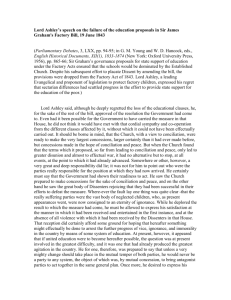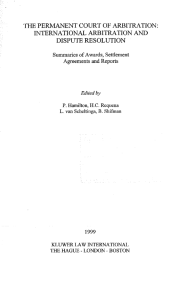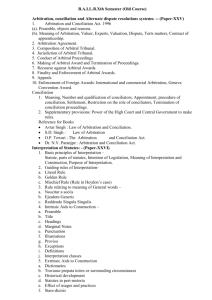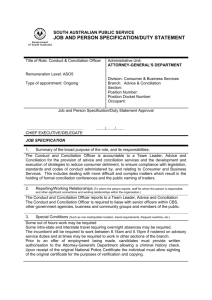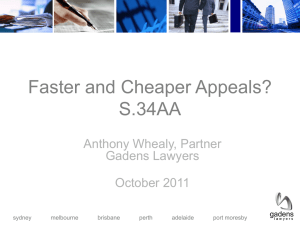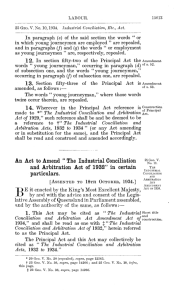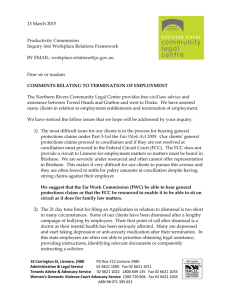Conciliation - De Pardieu Brocas Maffei
advertisement
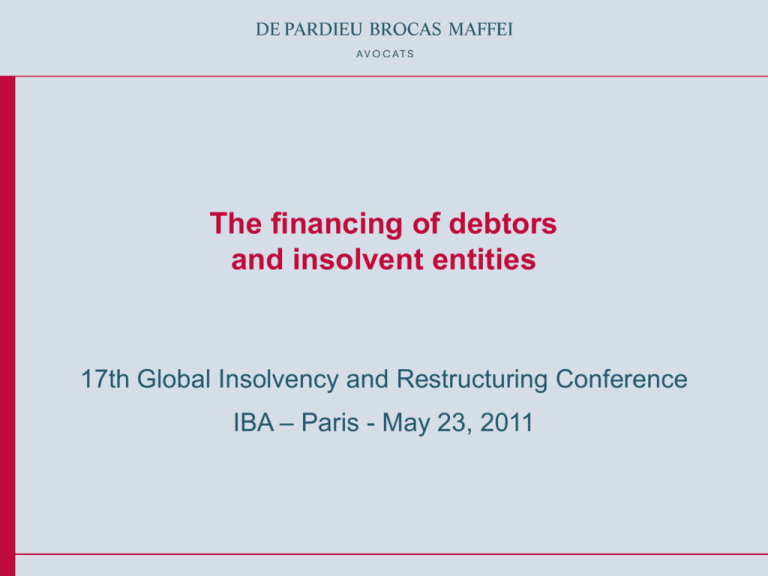
The financing of debtors and insolvent entities 17th Global Insolvency and Restructuring Conference IBA – Paris - May 23, 2011 © De Pardieu Brocas Maffei A.A.R.P.I. CONTENTS I. New Money : The French legal framework (the “conciliation” process since 2006) 1. “Conciliation” and New Money 2. Other “benefits” 3. Limits 4. Bits and pieces about conciliation 5. Ranking issues 5.1 New money providers vs. secured lenders 5.2 New money providers vs. secured lenders having lent to subsidiaries 6. New money and Capex : new drawings under existing Capex financing eligible to the statutory privilege ? 7. Recourses against the judgement approving a conciliation 2 © De Pardieu Brocas Maffei A.A.R.P.I. CONTENTS II. Case Study (industry : maritime transportation) 1. Overall goals and principles 2. Ways and means 3. More about the liquidity line 4. More about the retreatment of existing debt 5. Legal 6. Outcome 7. Developments since 3 © De Pardieu Brocas Maffei A.A.R.P.I. I. New Money : The French legal framework (the “conciliation” process since 2006) I. New Money : The French legal framework (the “conciliation” process since 2006) A subject matter deeply reformed in 2005. Purpose of the reform : induce lenders / service providers • to make new money (and services) available to a company in the early stage of anticipated difficulties and • to use the prepetition arrangement process known as conciliation, voluntary and necessarily consensual but nevertheless court-monitored (see below). Technique : statutory privilege securing new money + voidance risk eliminated + a blanket immunity from lender liability (but for limited exception). Prerequisite: the statutory privilege has to be granted pursuant to a conciliation agreement co-signed by the court-appointed agent(s) (the "conciliateur(s)“) and approved by the Court after a hearing in camera, the prosecutor in attendance (employees' reps too, but only to express their opinion on the scheme, no veto right). 4 © De Pardieu Brocas Maffei A.A.R.P.I. New Money : The French legal framework (the “conciliation” process since 2006) I. 1. “Conciliation” and New Money Any type of new money eligible to the privilege ? No, only “new cash (NB : including shareholders’ loans) (or services) the purpose/use of which is to finance the continuation of the company’s activity and to contribute to a viable future” (Com. Code art. L. 611-11). But technique used to fund irrelevant : loans, revolvers as well as letters of credit, hedging arrangements are eligible provided funds made available or the “service” provided are used exclusively to finance ongoing/continuing business activity. A contrario, no priority for providers of new cash used for the sole purpose of refinancing existing debt. Reminder: Courts can approve a conciliation agreement only if the following conditions are met: (i) the debtor is not (or is no longer as a result of actions/measures/efforts embodied in the agreement) insolvent ; (ii) the ways and means/waivers/postponements/new equity and other long-term resources, etc... provided for in the conciliation agreement are sufficient prima facie to warrant a viable/sustainable future for the debtor; (iii) the rights of creditors (usually the minor ones) which were (voluntarily) excluded by the company from the conciliation process are not adversely impacted. 5 © De Pardieu Brocas Maffei A.A.R.P.I. New Money : The French legal framework (the “conciliation” process since 2006) I. 2. Other « benefits » For lenders : • In case the company relapses, new money providers rank in a subsequent liquidation immediately below employees’ pre-filing unpaid salaries, trustee/liquidator’s unpaid fees and court costs (in a rehab situation, see below). • No subsequent backdating of the starting date of the so-called “période suspecte” (i.e. the hardening period) to a date prior to that of the Court judgment approving the conciliation agreement : => No voidance/claw back risk, if it was to appear, at a later stage, that the company was already insolvent during the conciliation period and in particular when the new money and new collateral were put in place. For the company : The conciliation provides, until the homologation judgment, a consensual and confidential (in principle) framework to negotiate a restructuring plan, with the assistance of a court agent, sometimes used by the debtor as a negotiating leverage since the “conciliateur” – most often chosen on the list of trustees – is likely – if the process fails – to become the future trustee of the bankrupt company. 6 © De Pardieu Brocas Maffei A.A.R.P.I. I. New Money : The French legal framework (the “conciliation” process since 2006) 3. Limits Since new money providers rank below the employees’ superprivilege (see below), in case the company is heavily staffed with few valuable disposable assets, the new money privilege can be of limited value. Often new money is to be extended prior to the close of the conciliation period without any guarantee that the conciliation protocol will be ultimately approved (an approval necessary to create the privilege) => the need expressed by creditors to obtain, in addition to the privilege, specific additional collateral to also secure the new money (or at least the drawings made prior to the approval judgement with nevertheless theoretically a residual risk of voidance if no Court approval at the end). No guarantee that the conciliation procedure even if successfully completed will not be followed by the hostile opening of voluntary proceedings, such as safeguard (procédure de sauvegarde) if the company is eligible, i.e. still solvent, or rehabilitation proceedings (redressement judiciaire) if insolvent. 7 © De Pardieu Brocas Maffei A.A.R.P.I. New Money : The French legal framework (the “conciliation” process since 2006) I. Consequences for new money providers (i) of a subsequent sauvegarde filing, (ii) of a rehabilitation, or even (iii) of a sauvegarde followed by a redressement /rehab (possible since 2008), themselves potentially followed by a liquidation: • Reminder : during the sauvegarde or redressement observation period (debtor has 6 to 18 months max to present a plan): - all principal repayments and payments of interests are frozen; - if the initial maturity of existing facilities was less than a year, interests cease to accrue - if the maturity exceeds a year, interests continue to accrue during the observation period but cannot be paid out and will be, after the 6, 12 or 18 months of the observation period, capitalized at the time the plan is adopted, and then rescheduled by the plan as principal. • at plan’s adoption : privilege survives but new money, even though privileged, can be rescheduled (since conciliation new money is technically a pre-filing debt and all pre-filing debts are termable in the plan). • Maximum possible length of an imposed term out : 10 years. 8 © De Pardieu Brocas Maffei A.A.R.P.I. I. New Money : The French legal framework (the “conciliation” process since 2006) "Sweeteners“ (in case of such subsequent term-out): • If an asset disposals program is part of the plan => the priority benefiting to new money providers in case the asset is disposed of in a subsequent liquidation is generally viewed as applying to such isolated asset disposal : priority should be in principle granted to conciliation new money providers over any other creditor (including mortgage creditors) on the allocation of proceeds of the asset disposed of (but no case law yet) . • In case new money providers also obtained specific collateral/charges on unencumbered assets, such survive and will be enforceable if the charged asset is subsequently sold, even if the disposal of such asset was not provided for in the plan. 9 © De Pardieu Brocas Maffei A.A.R.P.I. I. New Money : The French legal framework (the “conciliation” process since 2006) There is however a carve-out (and a caveat) to be made, and a major one: If the charged asset is a tangible asset included in a subsequent plan de cession (which cession plan can be adopted in rehab as an alternative to a plan de continuation), the adoption by the Court of a plan de cession (or of several partial plans in case of bidders bidding on different lines of business) operates as an automatic release of all existing charges and the secured creditor is only entitled to a share, decided by the Court discretionarily, of the price paid by the winning bidder. 10 © De Pardieu Brocas Maffei A.A.R.P.I. I. New Money : The French legal framework (the “conciliation” process since 2006) 4. Bits and pieces about conciliation Stay : none but in practice creditors, invited to do so by the conciliateur, most often voluntary refrain from seeking payment and/or taking enforcement actions or even attachments/provisional remedies. Should one or several creditors nevertheless seek payment, debtors can obtain from the judge having opened the conciliation, grace periods up to a maximum of 2 years, the law applicable to the loan agreement or contract and the contractual choice of jurisdiction being irrelevant. 11 © De Pardieu Brocas Maffei A.A.R.P.I. I. New Money : The French legal framework (the “conciliation” process since 2006) Grace periods an efficient remedy ? Quite efficient vis-à-vis French creditors even though limited in time (max 2 years). Potentially helpful vis-à-vis EU creditors (because of the EU expedited judgment recognition system (EU Reg. n°44-2001). NB : No automatic recognition of conciliation judgments in the EU contrary to sauvegarde, rehabilitation, or liquidation judgments. Can be used to temporarily protect assets located in France from seizure by non French/non EU creditors. Practically useless to protect assets located outside Europe, the time required to obtain enforcement of the French Judge’s decision in a non EU country through the Private International Law process of exequatur being generally viewed as enabling affected creditors to take interlocutory/protective measures or even make seizures in the foreign country. 12 © De Pardieu Brocas Maffei A.A.R.P.I. I. New Money : The French legal framework (the “conciliation” process since 2006) 5. Ranking issues New money providers vs. Secured lenders Assomptions: -New money made available within the framework of the court-approved conciliation agreement (accord de conciliation homologué) -All structured operating assets pledged or mortgaged -Conciliation followed by a subsequent sauvegarde or rehab or liquidation Hypothetical : Pledged/mortgaged asset sold after the conciliation (no subsequent sauvegarde/rehab/ liquidation) Hypothetical: Pledged/mortgaged asset sold as part of a subsequent sauvegarde plan Hypothetical: Pledged/mortgaged asset sold as part of a subsequent continuation plan in rehab Hypothetical: Pledged/mortgaged asset included in a business line auctioned in rehab (« plan de cession en RJ ») or in a liquidation with (a) (several) cession plan(s) Hypothetical: Pledged/mortgaged asset sold in a liquidation asset by asset (if no bidders for lines of business or auctionable surviving line) Solution: Proceeds paid to pledgees/ mortgagees (unless contractual waterfall agreed upon between new money providers and mortgagees was agreed in the conciliation agreement) Solution: Proceeds allocated in the following order: (1) new money providers; (2) pledgees/ mortgagees Solution: Proceeds allocated in the following order: (1) new money providers; (2) pledgees/ mortgagees Solution: Price paid by bidder allocated in the following order: (1) employees’ superprivilege; (2) Court costs Solution: Proceeds allocated by liquidator in the following order: (1) employees’ superprivilege; (2) Court costs; (3) new money providers; (4) pledgees/ Mortgagees 13 © De Pardieu Brocas Maffei A.A.R.P.I. I. New Money : The French legal framework (the “conciliation” process since 2006) NB 1: As an exception to the above, in sauvegarde or in rehabilitation, the insolvency judge may, during the observation period and at the request of the trustee, authorise the payment of a pre-filing creditor secured by a security interest with a retention right (droit de retention) even if such payment would result in a pre-filing creditor being paid before post filing creditors and of course before all other pre-filing creditors. The purpose of this exception is to obtain that the retained asset be surrendered to the estate. Reposession of the pledged asset must, however, be proven to the judge to be an absolute necessity for the pursuit of the debtor's business activity. NB 2: under French law, employee’s pre-petition claims benefit from a preferential status (superprivilège des salariés). If it pre-financed the pre-filing wages, the Wage Insurance System (AGS, a scheme run by the employers’ association aimed at prefinancing pre-filing salaries in arrears + post-filing severance indemnities), as well as court costs, i.e. essentially trustee’s and liquidator’s fees, always rank ahead of any other creditor in any type of proceedings. 14 © De Pardieu Brocas Maffei A.A.R.P.I. I. New Money : The French legal framework (the “conciliation” process since 2006) 5.2. New money providers vs. secured lenders having lent to subsidiaries French Mother Co Subsidiary 1 Subsidiary 2 Subsidiary 3 (French) (French) (French) Liquidity line Subsidiary4 French subsidiaries party to the court-approved conciliation French subsidiary outside the scope of the court-approved conciliation Foreign subsidiary outside the scope of the court-approved conciliation 15 © De Pardieu Brocas Maffei A.A.R.P.I. I. New Money : The French legal framework (the “conciliation” process since 2006) Scenario 1: New money (liquidity line granted to mother co.) (no new money granted to Subsidiary 1 and Subsidiary 2) No preference for new money providers in the estates of Subsidiary 1 and Subsidiary 2 should they fail (only in mother co’s estate). The proceeds of the sale of any mortgaged/pledged asset owned by Subsidiary 1 and Subsidiary 2 will be applied to the repayment of Subsidiary 1 or Subsidiary 2 lenders benefiting from a charge over the asset. This is true even if the asset is sold as part of a sauvegarde or a rehabilitation process at the level of mother co’s or at the level of Subsidiary 1 and/or Subsidiary 2, or in a liquidation of any of them). One exception: hypothetical of a consolidation of estates between mother co’s estate and that of Subsidiary 1 or of Subsidiary 2: piercing corporate veils is very rare in practice in France and subject to a strict commingling of assets test (a test narrowly interpreted by French courts for a recent precedent, see Metaleurop decisions). 16 © De Pardieu Brocas Maffei A.A.R.P.I. I. New Money : The French legal framework (the “conciliation” process since 2006) Scenario 2: New money (ex.: privileged Capex financing) granted in the framework of a court approved conciliation to which French mother co + Subsidiaries 1 and 2 (a) if the mortgaged/pledged asset owned by Subsidiary 1/Subsidiary 2 is sold after the conciliation (and before a subsequent sauvegarde/ rehab/liquidation of Subsidiary1/Subsidiary2, if any of course), proceeds will go to the lenders benefiting from the charge over the asset and not to the new money providers in conciliation (unless a contractual subordination was agreed as part of the conciliation between the new money providers and the pre-existing secured lenders). (b) if the mortgaged/pledged asset owned by Subsidiary 1/Subsidiary 2 is sold: • as part of an asset disposal program itself part of a sauvegarde or continuation plan adopted in the course of subsequent sauvegarde or rehab proceedings opened for Subsidiary 1/Subsidiary2, or • in the course of a liquidation, proceeds will be applied to repay (1) the new money providers to Subsidiary 1/Subsidiary 2 and (2) the secured lenders. 17 © De Pardieu Brocas Maffei A.A.R.P.I. I. New Money : The French legal framework (the “conciliation” process since 2006) Scenario 3: New money granted at the level of Mother Co. only and no new money granted to Subsidiary 3 (French but not in conciliation) and/or Subsidiary 4 (foreign) Same as Scenario 1 above. For foreign subsidiaries (including EU), the commencement of conciliation proceedings in France will have no automatic immediate effect outside France. (Indeed, conciliations do not appear in either Annex A or Annex B of EC Regulation n° 1346/2000 of 29 May 2000 on the automatic recognition of insolvency proceedings within the EU.) 18 © De Pardieu Brocas Maffei A.A.R.P.I. New Money : The French legal framework (the “conciliation” process since 2006) I. 6. New money and Capex : new drawings under existing capex financing eligible to the statutory privilege ? General view : new capex is eligible to the privilege. The Commercial Court of Paris recently approved a conciliation agreement where banks agreed to grant a new facility to a developer to allow construction works to resume: in that case, the pre-existing facility was cancelled and replaced by a new one benefiting from the privilege as a result of the court approval of the conciliation agreement). To minimize the risk that “new” drawdowns under an existing facility , if allowed, be considered - in spite of the fact that reactivating the facility is a way to allow an injection of new cash otherwise unavailable - as old money : (i) capex lenders and the company should both (i) acknowledge that several conditions precedent to new drawdowns under the existing facility are not fulfilled and will never be in the future, and (ii) formally agree to cancel all undrawn amounts under the existing facility; and (ii) provide in the conciliation agreement that the privilege was essential to the lenders’ consent to increase their risk exposure by reactivating a facility, which reactivating amounts to granting a new facility which lenders were free to refuse to extend. 19 © De Pardieu Brocas Maffei A.A.R.P.I. New Money : The French legal framework (the “conciliation” process since 2006) I. 7. Recourses against the judgement approving a conciliation The Court approval protects the agreement from the risk of future challenge, except • in case of fraud (i.e. of obvious misrepresentation made to the conciliateur and/or to the Court) or • if parties to the conciliation agreement consider that the agreement was not properly reflected in the judgment. (NB : The agreement is neither an appendix to the homologation judgment nor incorporated by reference but simply summarised in the judgment.) The homologation of a conciliation agreement being the result of a court process culminating in a judgment made available to the public (published in a legal gazette), the judgment is subject to challenges (tierce oppositions) by creditors which were not signatories to the agreement (and thus not part of the conciliation process). 20 © De Pardieu Brocas Maffei A.A.R.P.I. I. New Money : The French legal framework (the “conciliation” process since 2006) All homologation judgments can of course also be appealed by the public prosecutor (if, for instance, the prosecutors’ objection to the granting of the statutory privilege to certain beneficiaries was not taken into account by the judges of the Commercial Court). Appeals by prosecutors are extremely rare in practice and must, in any case, be launched within 10 days of the judgment being notified to the prosecutor's office, a very short appeal period which generally allow new money providers to postpone any drawing on the new facility until the appeal period has elapsed. As far as third party recourses (tierces oppositions), they too must be filed within 10 days, but of the publication of the homologation judgment in a legal gazette. 21 © De Pardieu Brocas Maffei A.A.R.P.I. II. Case Study (industry : maritime transportation) II. Case Study (industry : maritime transportation) 1. Overall initial (i.e. when crisis hit) goals and principles of company X’s restructuring - Maintain group as a going concern without the need for court protection (sauvegarde not a proper remedy essentially for its limited use outside the EU) - Concentrate on debt service (Cy needed the support of its Capex lenders to finance order book of ships) - Stabilize the capital structure of mother co. during the then expected duration of the (one year or more) downturn - Agree a sized down order book with the shipyards - Agree bank funding of such orders and LTV gap funding - Adjust contributions/efforts to the constituencies’ status unsecured/term loans/short term RCF/hedging banks, etc.) 22 (secured/ © De Pardieu Brocas Maffei A.A.R.P.I. II. Case Study (industry : maritime transportation) 2. Ways and means - Liquidity line : required almost immediately; to be structured as a bridge to equity - Procurement of equity : in a second stage (to be raised within 9 months max) for an amount at least equal to the liquidity line maximum amount - Waivers to be obtained from RCF’s lenders (problem of majority) to preserve near-term financing - Shipyards to accept to grant vendors’ loans + cancellation of some orders + delayed delivery for already financed ships - Hedge counterparties to renew hedging lines to agree to term out exposure at maturity (to the extent no freezing) - Increase of the maximum envelop of trade & receivables so far assigned to a small group of banks (there was an existing securitization program) - Assets disposals 23 © De Pardieu Brocas Maffei A.A.R.P.I. II. Case Study (industry : maritime transportation) 3. More about the liquidity line To be provided by existing banks (or a subset thereof) Super senior to the secured and unsecured creditors (seniorized through the conciliation privilege + additional collateral if available) Maturity : bullet (+/- 1 year) To be repaid via the equity injection, and through free cash Use of proceeds : OPEX exclusively (employees, suppliers, etc.) NB : The possibility to use the liquidity line to pay margin calls and to fund « non-funded » Capex as per BP was discussed but there was no consensus. 24 © De Pardieu Brocas Maffei A.A.R.P.I. II. Case Study (industry : maritime transportation) Prerequisites: - Governance - Standstill - Payment of all interests including those in arrears - Liquidity covenant Condition precedents : - Bondholders’ and other’s waivers (if needed) Homologation by the Court of the conciliation agreement recognizing the benefit of the statutory privilege to the liquidity line lenders 25 © De Pardieu Brocas Maffei A.A.R.P.I. II. Case Study (industry : maritime transportation) 4. More about the retreatment of existing debt Key principles : - Unsecured creditors termed out - Short-term secured creditors (<5yrs) also termed out but with a yearly amortization + balloon - Long-term secured creditors (>5yrs) forego scheduled amortization for 2 years. Accelerated amortization catch up schedule thereafter To achieve : - DSCR of >1.0x - Net debt/EBITDA close to exiting covenant levels - EBITDA/interests of >3.0x 26 © De Pardieu Brocas Maffei A.A.R.P.I. II. Case Study (industry : maritime transportation) 5. Legal Sauvegarde not a remedy Conciliation initiated in February 2010, reluctantly, by company to allow new money providers to benefit from the statutory privilege Grace periods imposed to creditors which did not participate to the conciliation Suppliers’ credit used to buy time and delay the moment when the liquidity line lenders’ term sheet had to be accepted => provisional remedies sought by some suppliers but dealt with 27 © De Pardieu Brocas Maffei A.A.R.P.I. II. Case Study (industry : maritime transportation) 6. Outcome Surprising… Unexpected upturn in freight rates and volumes in mid 2010 allowed company to do without the liquidity line Suppliers (some of which dependant) proved quite flexible in terms of payment delays Only 2 creditors representing less than 5% of the total debt eventually signed the conciliation agreement which was approved by Court in July 2010 (conciliation process has to be completed a maximum 4 + 1 months period) 7. Developments since Quasi-equity raised in the form of mandatory convertibles in January 2010 28 © De Pardieu Brocas Maffei A.A.R.P.I.
